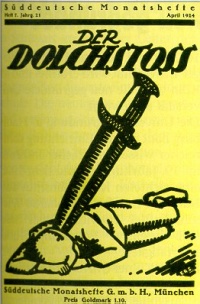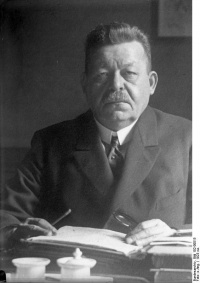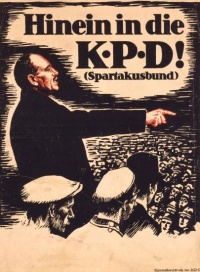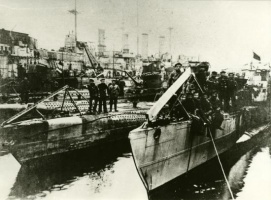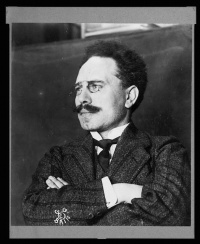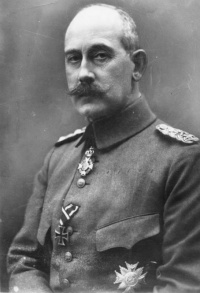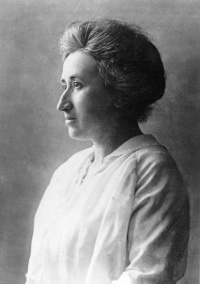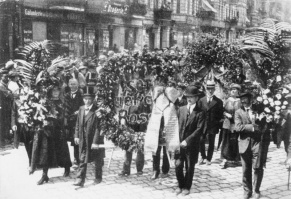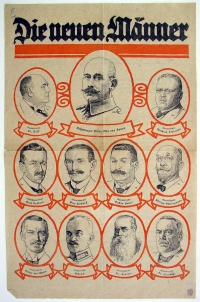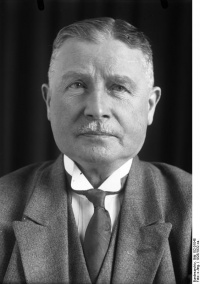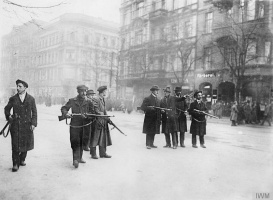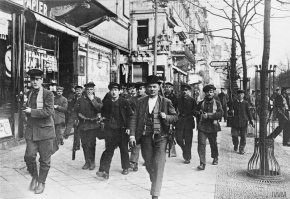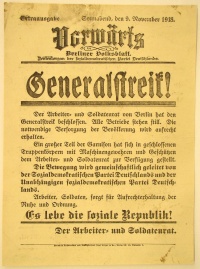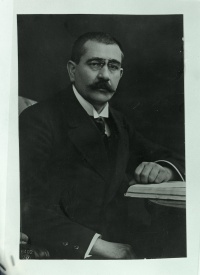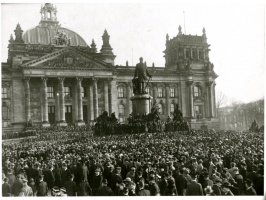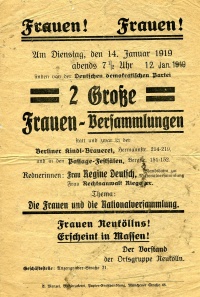Introduction↑
During the Cold War, the German revolution of 1918-19 was a focal point that provoked fierce controversies. Historical arguments mixed with political ones, frequently reflecting the zeitgeist. Of the once fiercely contested debates over the alternative of liberal democracy versus Bolshevism, over missed chances and unutilised policy options, over “third ways” and a greater degree of “democratisation”, scarcely a trace remains today. Anyone glancing at the state of research since the 1990s or at the degree of public awareness of the upheaval that accompanied the First World War's end has some occasion to speak of long-frozen controversies and a “forgotten revolution”.[1] The so-called “November Revolution” has not yet found a stable place in the history of German democracy. In cultural memory, this date simply marks the beginning of the end of a development that led in 1933 to dictatorship – instead of to a democratic republic whose downfall was not preordained.
Several trends in current research indicate, however, that these often normatively laden or even quasi-teleological interpretations are increasingly being replaced by a more open view of the Weimar Republic and the interwar period in general. Recent studies inspired by the history of political culture, for instance, treat "crises" not in terms of quasi-inevitable linear scenarios of decline, but interpret them as fluid transitional periods of open decision situations and negotiation processes.[2] This corresponds with a view of the 1920s and 1930s as a period best described with the metaphor of a “laboratory” for testing political-social models. As early as 1918, Tomáš Masaryk (1850-1937), first President of the newly created Czechoslovakian state, called post-war Europe “a laboratory built over the great graveyard of the World War”.[3]
The crisis of liberalism together with the erosion of monarchical legitimating patterns provided room for experimentation with new options of political organization. Supplanting the polemical, often normatively charged term revolution, some scholars grasp the transformations between different forms of government using the political science instruments of system change (transitions, regime change).[4] Such an analysis is conducive to systematisation and objectification and at the same time simplifies comparison across countries. In addition, transnational transfers and interconnections are increasingly becoming the focus of attention. This is all the more appropriate as, within Europe, the conflict between empire and nation first fully unfolded at the end of the First World War.[5] That is applicable to the German Empire and still more to the dissolved Habsburg Empire. Research into political violence, which focuses on the dynamics of revolution and counter-revolution, has also opened new transnational perspectives on the years between 1917 and 1923.[6] As yet, however, a transnational history of those years can at best be dimly discerned. This may also lie in the actual constellation around the autumn of 1918, namely in the “fragmentation of a potentially European and global revolutionary situation.”[7] For Michael Geyer, the revolution in 1918/19 was “a polemical foundation of regime/order” that aimed to transform polities and societies internationally. Located in a “fracture zone of nations, empires and ideologies" and based on a “utopia of global expectations”, it ultimately remained limited and fragmentary.[8]
What changes took place in detail, and how? What steps of transition can plausibly be reconstructed? These details will be traced below for the German Empire. The conclusion will roughly sketch similarities and differences among the various cases in Central Europe after 1918 and suggest transnational transfers and correlations. Paradoxically, transnationalism played a significant role in cases of nationalistic paramilitary organisations.
The Creeping Decline of the German Empire↑
It is both tempting and all too simple to ascribe the end of the Empire purely to German defeat in the First World War, thus making external causes responsible for the abrupt collapse of the regime. It is necessary to go back before the landmark year 1918 and acknowledge structural weaknesses and asynchronies in the German Empire without reviving the deterministic thesis of the German Sonderweg (“special path”).[9] Anyone stressing the contradiction between an illiberal political order and rapid socioeconomic modernisation must not however overlook the progress in practical parliamentary experience, democratisation and rule of law.[10] The tension between old and new, between tradition and modernity, between awakening and upheaval, between self-assurance and doubt, between optimism about progress and cultural pessimism made the Empire an uneasy entity overall.[11] Even if the editor-in-chief of the liberal “Berliner Tageblatt”, Theodor Wolff (1868-1943), spoke euphorically of the “greatest of all revolutions” on 10 November 1918 and compared it with a sudden “tempest”; this view of a spontaneous upheaval produced by war and defeat falls short of the mark. Rather, the revolution had long been maturing “in the bosom of Wilhelminian society.”[12]
The creeping decline in the monarchy's legitimacy showed itself through various symptoms, such as in the shift of decision-making power from the emperor to the military leaders in the course of the war and in the hunger revolts and mass protests of January 1918, which generated a systemic crisis. Arthur Rosenberg (1889-1943) already detected in this a dress rehearsal for the November revolution. Notwithstanding such signs, the admission of defeat by the Supreme Command in September 1918 came as a shock to the public and politicians. After all, the peace agreement of Brest-Litovsk with Soviet Russia in the spring of 1918 had again fed hopes of a German victory, even if little else had.
The upheavals in the autumn of 1918 can be roughly subdivided into two phases: first a “revolution from above” and second a “revolution from below”. The latter in turn resolved into two stages: (1) from the overthrow of the state in early November 1918 over the breakup of the governing coalition of the Majority and Independent Social Democratic Parties (MSPD and USPD) at the end of December to the establishment of the National Assembly in January 1919; (2) from then until the spring of 1919, marked by an increasingly radical mass movement against the imperial government, which confronted the imminent loss of authority and power by military means.
Different Phases of Transition↑
The first transformation phase, directed from “above”, began at the end of September 1918, as the German Supreme Command requested a ceasefire in accord with the “Fourteen Points” of United States President Woodrow Wilson (1856-1924). The Allies, however, were no longer disposed to such an accommodation and offered a ceasefire that was virtually equivalent to an unconditional capitulation. In addition, they no longer wished to negotiate with agents of the German military, but insisted on the establishment of a democratically legitimated government. In this sense, Wilson’s series of diplomatic notes influenced the parliamentarisation of the Empire. If this alone were the deciding factor, one would have to speak of a “revolution from outside”. Further aspects, however, supervened.
First, the military leadership of the Empire endorsed, if not without the ulterior motive of legitimating/establishing the soon-to-be-coined Dolchstoßlegende (“stab-in-the-back legend”),[13] a revision of the constitution towards parliamentarianism; second, the majority factions in the Interfraktioneller Ausschuss (“Interfactional Committee”) of the Reichstag in particular advocated such a development, in part to prevent the “chaos” of a revolutionary mass movement from below. The newly formed government under Imperial Chancellor Max von Baden (1867-1929), which included representatives of social democracy, the Catholic Centre and the liberals' left wing, got constitutional reform off the ground against a background of constantly increasing pressure through Wilson’s exchange of notes. On 28 October, the so-called “October reforms”, which marked the transition from a constitutional to a parliamentary monarchy, came into effect.
In light of the October reforms, the November revolution may appear quasi-superfluous in “technical constitutional” terms[14], but this was by no means the case politically. The change of forms of government in October lacked the character of a turning point in contemporary public perception. In view of the material hardships, the looming spectre of defeat and the continued existence of the monarchy (albeit under fundamentally altered conditions), there was little room for a theoretical discussion about political concepts of order. And the public mood was not ready to be satisfied with a mere paper constitutional reform.
The “revolution from below”, which likewise started at the end of October, pressed for the abdication of the Kaiser as the strongest symbol of the end of the old order. The political aims of the newly founded workers and soldiers’ councils were diffuse, and their actions were peaceful and disciplined at the time, but they indeed sought the overthrow of the Ancien Régime. As early as 7 November, the regime and the monarchy in Bavaria fell, and Kurt Eisner (1867-1919) proclaimed a republic. When the insurrectionary movement reached Berlin on 9 November, Prince Max von Baden – incidentally without official authorisation and a few hours before Wilhelm II, German Emperor’s (1859-1941) decision – made the abdication of the Kaiser and the Crown Prince public. He transferred the office of Chancellor to the leader of the MSPD, Friedrich Ebert (1871-1925). The pressure on the Chancellor and Kaiser to carry out the abdication was increased from the start by an ultimatum from the Social Democrats. On the advice of the Supreme Army Command, Wilhelm fled to Holland on 10 November and signed the renunciation of the throne shortly thereafter – on 28 November.
Conflicting Ideas of the New Political Order↑
Leading Social Democrat Philipp Scheidemann (1865-1939) proclaimed the republic from a balcony of the Reichstag building not long after the abdication was announced, around two o’clock in the afternoon of 9 November 1918. With his improvised speech, Scheidemann made two things clear: first, the MSPD's claim to leadership within the revolution, towards which they themselves had ambivalent feelings; second, his party's perception that the revolution had already attained its objective and that henceforth it was a matter of consolidating the new republican order.
The difficulty of establishing the republic upon consensus is also documented by the fact that, around two hours after Scheidemann’s declaration, the “Spartacist” Karl Liebknecht (1871-1919) declared the “Free Socialist Republic of Germany” in the Lustgarten before the castle, stylising it as an intermediate stage on the road to a global communist revolution. No royalist resistance mobilised to battle for the monarchy.[15] Instead, a conflict broke out within the left political spectrum for the future configuration of the new democracy. Ebert, head of the government as well as the Majority Social Democrats, and a “reluctant revolutionary”[16], promised to speedily convene a National Constitutional Assembly. The aim was to foil left-wing socialist council experiments and, even more pressing, a Bolshevik-style revolution in Germany. The Social Democratic Party had split during the First World War, in 1917, into Majority and Independent Social Democrats; the loosely organised “Spartacus Group” around Karl Liebknecht and Rosa Luxemburg (1871-1919). Pointedly and paradoxically, Heinrich August Winkler called the split in the workers' movement “a heavy handicap and a precondition of the first German democracy” (“Vorbelastung und Vorbedingung”).[17]
The Majority Social Democrats sought to avoid any further radicalisation. Their essential and immediate objective was the convening of a democratically elected National Assembly. The agenda-setting for the future arrangement of state and society was to take place exclusively there. The majority of delegates/deputies to the first Congress of Workers’ and Soldiers’ Councils ultimately voted in favour of the Majority Social Democrats call for elections to a National Constitutional Assembly on 19 January 1919. From a constitutional and democratic theory perspective, there is a good argument to be made in praise of the Majority Social Democrats for their sense of responsibility and their unswerving adherence to the goal of parliamentary democracy. Yet their approach appears in a number of respects to have been all too cautious. Their fear of chaos and their insistence on administrative continuity, for instance, spared the old administrative and military establishment to an unnecessary extent. On the other hand, the counterfactual question of whether a greater turnover in elites would have entailed excessive disintegration cannot be categorically answered. In any case, given the inadequate changeover of ruling elites and limited socioeconomic change, many rebels felt the first phase of the revolution to be a “time of disappointments”.[18]
Radicalization, Violence and Dissent↑
The members of the USPD in the Council of People’s Deputies quit the government as early as the end of December 1918 over serious differences of opinion (in particular about the military action against a sailors’ mutiny at Christmas). Shortly thereafter, in the first days of January, Liebknecht, as leader of the newly formed Communist Party of Germany, called for the purely MSPD Ebert-Scheidemann government to be overthrown. The People’s Deputies demonstrated their resolve violently to suppress this attempted coup (“Spartacist uprising“). Decisive resistance was necessary, but the severity exercised in conjunction with aggressive paramilitary units, which murdered Liebknecht and Luxemburg on 15 January 1919, was not. These events contributed to the escalation of violence in spring 1919 and put Germany in a near state of civil war. The increasingly radicalised mass movement came into increasing opposition to the new government, which in turn was ever more reliant on military means to safeguard its authority. Ebert had forged an agreement with General Wilhelm Groener (1867-1939) securing the loyalty of the military towards the new government on 10 November 1918.
In retrospect, the first phase of the “revolution from below” appears as the “formative”[19] one, whereas the second phase of radicalisation and violent conflict attempted unsuccessfully to revise the failures – at least in the view of the rebellious workers – of the first revolution period. Ultimately, the social balance of power remained fundamentally untouched. Certainly, significant social reforms such as the introduction of the eight-hour day by the Central Community of Labour (Zentralarbeitsgemeinschaft) set up at the start of December (Stinnes-Legien Agreement) should be mentioned as the beginning of the “social partnership” between capital and labour in Germany. The second phase of the revolution bore a violent countenance. In many places, especially in the industrial centres, there were general and mass strikes; in Bremen and in Munich Soviet republics were established. The political situation did not calm down before May 1919, with the abolition of the second Munich Soviet Republic, and even then assassinations and attempted coups acutely strained the Weimar Republic into 1923.
From the outset the system change of 1918/19 remained an unloved revolution. It is thus fundamentally astonishing that a revolution that was rejected from every political direction – even if for very different reasons – was ultimately successful insofar as it managed to transform Germany for the first time into a parliamentary democracy. From a structural, institutional point of view, these were considerable achievements. From the perspective of German society at the time, however, the fact that the political upheavals were not connected with any legitimating, powerful founding myth, but rather sowed substantial dissent, would come back to haunt the republic.
In the elections for the National Constitutional Assembly on 19 January 1919 – with women participating for the first time in German history[20] – the parties of the “Weimar coalition” (MSPD, Centre and DDP) had at least won more than three-quarters of the votes in aggregate. With the signing of the Treaty of Versailles on 28 June and the adoption of the Weimar Constitution on 31 July 1919, the basic external and internal conditions for the further development of the first German democracy had finally been secured. The Weimar Constitution, largely drafted by the liberal constitutional law professor Hugo Preuß (1860-1925), constituted the Reich as a parliamentary republic.
It would soon become clear, however, how much constitutional theory and constitutional reality could diverge. The parties of the Weimar Republic found it difficult to internalise the central divide of a parliamentary system between government majority and opposition minority. Rather, they clung to the old division of the constitutional monarchy – between government on the one side and Reichstag on the other. The “Weimar Coalition” broke up irretrievably as early as 1920. In fourteen years the Republic had twenty governments, eight parliaments and two presidents. Additionally, the dysfunctions of the Weimar government system were overshadowed in the years 1920 to 1923 by numerous violent assaults and clashes, culminating in the putsch attempts of autumn 1923. A political culture of civil war took a deep hold in people’s minds, well beyond the confines of this year of crisis.
Conclusion↑
Looking at the collapsing Empires in Central Europe in the years 1918-19, we can trace political transitions to parliamentary democracies that lasted some time in Germany and Austria. After a short period of civil-democratic and socialist experiments, Hungary experienced an authoritarian swing to the right that endured well into the Second World War.[21] The deeper causes for the end of both the German and the Habsburg Empires were grounded in numerous socio-political ambivalences and inconsistencies. Under the pressure of the First World War, they led to a systemic crisis. Various circumstances spurred them on the road to parliamentary democracy: the external pressure of US President Woodrow Wilson (“Wilsonian Moment”[22]) must be mentioned alongside the internal coalitions between (reformist) Social Democrats and bourgeois-liberal forces. And with the foundation of the new governments, old elites from the military and the monarchy were only too happy to pass on the burden of defeat. Here lay the root of “stab-in-the-back thesis”, which evolved with varying intensity in Germany, Austria and Hungary. According to this fatal reading, democracy and defeat inseparably belonged together.
From an institutional, constitutional and political-ideological point of view, the success of the transition varied. The first two components were fulfilled in Germany and Austria, if sometimes in a rough-and-ready fashion. The attainment of the third aspect, a necessary condition for the long-term success of a transition from an authoritarian to a democratic political system, ultimately foundered on insurmountable cleavages between the parties, ideologies and ethnic groups. A pluralistic conflict settlement scarcely existed, and broad political-cultural acceptance of the new order was lacking. Isolated achievements in social policy/reform could do nothing to change this.
The warlike polarisation of political culture was accompanied at the beginning of the 1920s and beyond by actually bloody conflicts. Defeat in war, state collapse or at least a change in the form of government, the perceived Bolshevik threat as well as state and ethnic conflicts spawned outbreaks of violence in varying qualitative and quantitative manifestations. Particularly violent excesses occurred “in the disputed shatter zones on the edges of the Habsburg, Hohenzollern and Romanov empires”.[23]
It is interesting to note that not only did adherents of communism on the one hand and advocates of liberal democracy on the other nurture transnational aspirations (condensed in the formula: “Wilson or Lenin?”) and cultivate cross-border networks, but radically nationalistic paramilitaries did so as well: “These activists formed a fairly homogenous transnational milieu of predominantly middle- and upper-class political radicals characterized by youth and war-induced militancy.”[24] This counter-revolutionary movement lacked a clear ideology or even a positive programme, taking first monarchist, then proto-fascist, then neo-conservative forms.[25] Unity existed above all in one goal: toppling republican governments and/or beating down communist stirrings. They were thus anti-democratic and anti-Bolshevist at once. They identified their “internal” enemies as Jews, left-wing politicians and intellectuals and “politicised” women. In groups marked by ultra-violent masculinity and manliness rituals, the advent of women as voting citizens conjured up a not-to-be-underestimated scenario of threat. This was most manifest in the “White Terror”, which was also an excessive reaction to the “Red Terror”, in Hungary, where – unlike in Germany or Austria – large-scale terror campaigns ensued. There is some evidence that in areas of secessionist nationalism[26] the manifestations of violence were particularly excessive.
All in all, this indicates that it is apposite to speak with Richard Bessel of a “post-war” instead of a “peacetime” society.[27] Instead of interpreting this period at the end of the First World War as a succession of isolated revolutionary or counter-revolutionary eruptions, it seems reasonable rather to see it as a phase of dynamic, chaotic and competing concepts of morality and order with an open-ended outcome. Areas of conflict grew, arising inter alia from ideological rivalries and the transitions from empire to nation as well as the relationships between victors and vanquished, (ethnic) minorities and majorities, urban and rural structures, and “politicised” women and rituals of manliness. Research into this hard-to-disentangle web of transitions, fragmentations and entanglements in an age of upheaval needs to be further intensified.
Alexander Gallus, Universität Rostock / Technische Universität Chemnitz
Section Editor: Christoph Cornelißen
Notes
- ↑ Gallus, Alexander (ed.): Die vergessene Revolution von 1918/19, Göttingen 2010; see also Niess, Wolfgang: Die Revolution von 1918/19 in der deutschen Geschichtsschreibung. Deutungen von der Weimarer Republik bis ins 21. Jahrhundert, Berlin 2012.
- ↑ See Föllmer, Moritz/Graf, Rüdiger (eds.): Die „Krise“ der Weimarer Republik. Zur Kritik eines Deutungsmusters, Frankfurt am Main 2005; Canning, Kathleen/Barndt, Kerstin/McGuire, Kristin (eds.): Weimar Publics / Weimar Subjects. Rethinking the Political Culture of Germany in the 1920s, New York 2010.
- ↑ Müller, Jan-Werner: Contesting Democracy. Political Ideas in Twentieth-Century Europe, New Haven 2011, p. 50.
- ↑ See for instance Weyland, Kurt: Diffussion Waves in European Democratization. The Impact of Organizational Development, in: Comparative Politics 45 (2012), pp. 25-45; Jesse, Eckhard: Systemwechsel in Deutschland. 1918/19 – 1933 – 1945/49 – 1989/90, Cologne et al. 2010.
- ↑ See Raphael, Lutz: Imperiale Gewalt und mobilisierte Nation. Europa 1914-1945, Munich 2011; Mazower, Mark: Dark Continent. Europe’s Twentieth Century, London 1999, pp. 40-76.
- ↑ See Bloxham, Donald/Gerwarth, Robert (eds.): Political Violence in Twentieth-Century Europe, Cambridge 2011; Gerwarth, Robert/Horne, John (eds.): War in Peace. Paramilitary Violence in Europe after the Great War, Oxford 2012.
- ↑ Geyer, Michael: Zwischen Krieg und Nachkrieg – die deutsche Revolution 1918/19 im Zeichen blockierter Transnationalität, in: Gallus, Revolution, p. 192.
- ↑ Ibid., p. 195.
- ↑ The Sonderweg theory asserted Germany’s special and mistaken path (divergent from the liberal west) to modernity, culminating in two World Wars and the Shoah. See Walser Smith, Helmut: What the Sonderweg Debate Left Us, in: German Studies Review 31 (2008), pp. 225-240.
- ↑ See Anderson, Margaret L.: Practicing Democracy. Elections and Political Culture in Imperial Germany, Princeton 2000.
- ↑ See Heidenreich, Bernd/Neitzel, Sönke (eds.): Das Deutsche Kaiserreich 1890-1914, Paderborn et al. 2011; Müller, Sven Oliver/Torp, Cornelius (eds.): Das Deutsche Kaiserreich in der Kontroverse. Probleme und Perspektiven, Göttingen 2008; Jeffries, Matthew: Contesting the German Empire 1871-1918. Contesting the Past, Oxford 2007.
- ↑ Ullrich, Volker: Zur inneren Revolutionierung der wilhelminischen Gesellschaft des Jahres 1918, in: Duppler, Jörg/Groß, Gerhard P. (eds.): Kriegsende 1918. Ereignis, Wirkung, Nachwirkung, Munich 1999, p. 273.
- ↑ The stab-in-the-back-myth was established at the end of the First World War. The notion that the German army did not lose the war but was betrayed by the home front, especially by democrats and republicans, was popular in right-wing circles during the whole Weimar period. This efficacious legend poisoned Weimar’s political culture. See Barth, Boris: Dolchstoßlegenden und politische Desintegration. Das Trauma der deutschen Niederlage im Ersten Weltkrieg 1914-1933, Düsseldorf 2003.
- ↑ Mai, Gunther: Das Ende des Kaiserreichs. Politik und Kriegführung im Ersten Weltkrieg, Munich 1987, p. 169.
- ↑ See Machtan, Lothar: Die Abdankung. Wie Deutschlands gekrönte Häupter aus der Geschichte fielen, Berlin 2008.
- ↑ Nipperdey, Thomas: Deutsche Geschichte 1866-1918, Vol. 2: Machtstaat vor der Demokratie, Munich 1995, p. 873.
- ↑ Winkler, Heinrich August: Vom Kaiserreich zur Republik. Der historische Ort der Revolution von 1918/19, in: Winkler, Streitfragen der deutschen Geschichte. Essays zum 19. und 20. Jahrhundert, Munich 1997, p. 59.
- ↑ Peukert, Detlev: Die Weimarer Republik. Krisenjahre der Klassischen Moderne, Frankfurt am Main 1987, p. 44.
- ↑ Winkler, Kaiserreich 1997, p. 66.
- ↑ See Canning, Kathleen: Das Geschlecht der Revolution – Stimmrecht und Staatsbürgertum 1918/19, in: Gallus, Revolution 2010, pp. 84-116.
- ↑ See Cornwall, Mark: Austria-Hungary and “Yugoslavia”, in: Horne, John (ed.): A Companion to World War I, Oxford et al. 2010; Boyer, John W.: Silent War and Bitter Peace: The Revolution of 1918 in Austria, in: Austrian History Yearbook 34 (2003), pp. 1-56; Bodó, Béla: Paramilitary Violence in Hungary after the First World War, in: East European Quarterly 38 (2004), pp. 129-172; Maier, Charles: Political Crisis and Partial Modernization: The Outcomes in Germany, Austria, Hungary, and Italy after World War I, in: Bertrand, Charles L. (ed.): Revolutionary Situations in Europe, 1917-1922: Germany, Italy, Austria-Hungary, Montreal 1977, pp. 119-130.
- ↑ Manela, Erez: The Wilsonian Moment. Self-Determination and the International Origins of Anticolonial Nationalism, Oxford 2007.
- ↑ Conway, Martin/Gerwarth, Robert: Revolution and counter-revolution, in: Bloxham, Donald/Gerwarth, Robert (eds.), Violence 2011, p. 152.
- ↑ Gerwarth, Robert: The Central European Counter-Revolution: Paramilitary Violence in Germany, Austria and Hungary after the Great War, in: Past and Present 200 (2008), p. 180.
- ↑ See ibid., p. 187.
- ↑ Referring to this conceptualization by Theodor Schieder see: Schumann, Dirk: Europa, der Erste Weltkrieg und die Nachkriegszeit: eine Kontinuität der Gewalt, in: Journal of Modern European History 1 (2003), p. 31.
- ↑ Bessel, Richard: Germany after the First World War, Oxford 1993.
Selected Bibliography
- Bessel, Richard: Germany after the First World War, Oxford; New York 1993: Clarendon Press; Oxford University Press.
- Bodó, Béla: Paramilitary violence in Hungary after the First World War, in: East European Quarterly 38/2, 2004, pp. 129-172.
- Boyer, John W.: Silent war and bitter peace. The revolution of 1918 in Austria, in: Austrian History Yearbook 34, 2003, pp. 1-56.
- Carsten, Francis L.: Revolution in central Europe, 1918-1919, Berkeley 1972: University of California Press.
- Fischer, Conan: 'A very German revolution'? The post-1918 settlement re-evaluated, in: Bulletin for the German Historical Institute London 28/2, 2006, pp. 6-32.
- Führer, Karl Christian / Mittag, Jürgen / Schildt, Axel et al. (eds.): Revolution und Arbeiterbewegung in Deutschland 1918-1920, Essen 2010: Klartext Verlag.
- Gallus, Alexander: Die vergessene Revolution von 1918/19, Göttingen 2010: Vandenhoeck & Ruprecht.
- Gatrell, Peter: War after the war. Conflicts, 1919-23, in: Horne, John (ed.): A companion to World War I, Chichester; Malden 2010: Wiley-Blackwell, pp. 558-575.
- Gerwarth, Robert: The Central European counter-revolution. Paramilitary violence in Germany, Austria and Hungary after the Great War, in: Past and Present 200/1, 2008, pp. 175-209.
- Gerwarth, Robert; Horne, John: Vectors of violence. Paramilitarism in Europe after the Great War, 1917–1923, in: The Journal of Modern History 83/3, 2011, pp. 489-512.
- Gerwarth, Robert / Horne, John (eds.): War in peace. Paramilitary violence in Europe after the Great War, Oxford 2012: Oxford University Press.
- Gusy, Christoph (ed.): Demokratie in der Krise. Europa in der Zwischenkriegszeit, Baden-Baden 2008: Nomos.
- Maier, Charles: Political crisis and partial modernization. The outcomes in Germany, Austria, Hungary, and Italy after World War I, in: Bertrand, Charles L. (ed.): Revolutionary situations in Europe, 1917-1922, Germany, Italy, Austria-Hungary, Montreal 1977: Interuniversity Centre for European Studies, pp. 119-130.
- Mai, Gunther: Europa 1918-1939. Mentalitäten, Lebensweisen, Politik zwischen den Weltkriegen, Stuttgart 2001: Kohlhammer.
- Niess, Wolfgang: Die Revolution von 1918/19 in der deutschen Geschichtsschreibung. Deutungen von der Weimarer Republik bis ins 21. Jahrhundert, 2013.
- Ullrich, Volker: Die Revolution von 1918/19, Munich 2009: C.H. Beck.





